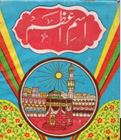
الاسم الأعظم
An overview on the Arabic word Baha' for Baha'is the quintessence of the Mightiest or Greatest Name of God (al-ism al-a`zam). Revised Notes frm pre-2010.
Stephen Lambden.
August 1992 rev. 2012 May 2014.
Under revision and reformatting - 27-02-2017.
The Significance of the Mightiest Name of God in Islamic Literatures
and in the Bābī and Bahā’ī Sacred writings.
بهاء
The Bābī-Bahā’ī Messianic Theology of the Arabic word Bahā’ with some notes on its semantic field and linguistic history in the light of its status for Bahā’īs as the Quintessence of the Greastest Name of God.
“O Peoples of the world! He Who is the Most Great Name (al-ism al-a`ẓam) is come, on the part of the Ancient King” (Bahā'-Allāh, ESW:128)
“Let your joy be the joy born of My Most Great Name (ismī al-a`ẓam), a Name that bringeth rapture to the heart, and filleth with ecstasy the minds of all who have drawn nigh unto God” (Bahā'-Allāh , Aqdas 38, para. 31)
1.0 Introduction
The linguistic history, semantic field and multifarious occurrences of the word bahā' in Arabic and Persian Islamic literatures has yet to be systematically researched. It is a word which does not occur in the Qur'ān and is not among the traditional ninety nine "most beautiful names" of God (al-asmā' al-unā ; see Qur'ān 7:179). It is thus considered "hidden". The Arabic word bahā' was not unknown prior to the advent of Bahā’-Allāh. Its explicit identification with the al-ism al-a`zam (Per. ism-i a`zam) the Mightiest or "Greatest Name"of God, however, despite Shi`i Islāmic traditions to this effect, was not widely recognized, An example of one so initiated might, for example, be considered Baha' al-Din al-Amili (d. ), known as Shaykh Baha'i. As the secret of the hundredth name of God, bahā' is often alluded to in Bahā’-Allāh's thousands of alwah or scriptural Tablets as the "Hidden Name" and the "Greatest Name".
The word bahā', as well as derivatives from the same Arabic root, are also found in the titles of certain Islāmic books and treatises. There existed, for example, a work about language called Kitāb al-Bahā' ("The Book of Bahā'/ Splendour") by the celebrated grammarian Abū Zakariyyā' Yayā ibn Ziyād [al-Aqa` al-Daylamī], known as al-Farrā' (d. 207/822; on him see Carter, CHAL:123ff) -- his work is listed in the massive Shī`ī bibliography of Āghā Buzurg al-Tehrānī, al-Dharī`a .. (see Vol. 3:157 No. 550) -- as also a number of others works whose titles are of interest; including, three works entitled Risāla al-bahīyya ("The Luminous Treatise"). (see ibid, Nos 587f.). Several Shī`ī writers composed books entitled, al-Anwār al-bahīyya ("The Glorious Lights") (for some details see ibid 3:420-1 Nos. 1661-1662 cf. also ). Examples of the Islamic use of bahīyya ("luminous") are numerous.
This chapter is an attempt to explore some linguistic, historical and theological aspects of the Arabic word بهاء bahā' which is viewed by Bahā'īs as the quintessence of the الاسم الأعظم , al-ism al-a`ẓam, the Mightiest or Greatest Name of God 1 one form of which they regard as the (Arabic) title الله بهاء = Bahā’-Allāh (= Bahā’u’llāh) which could be correctly translated in several different ways; e.g, the Glory-Splendor-Radiance-Beauty of God though modern Bahā’īs, following the preference of `Abd al-Bahā’ and Shoghi Effendi, translate `the Glory of God’ where ‘glory’ is expressive of the divine radiance and splendor personified in the person of Mīrzā Ḥusayn `Alī Nūrī (b. Tehran [Iran] 1817, d. Acre [Palestine] 1892 CE) who adopted the title Jinab-I Bahā’ (His eminence the Splendour), and subsequently Bahā’-Allāh, while a follower of the Bāb around the time of the conference of Badasht in 1848 CE (so Zarandī, Tarīkh, XXX in Dawn-Breakers, ). This title Bahā’-Allāh thus basically indicates a radiant divine theophany, a divine Manifestation attended and personified as a supernatural radiance, emanating light, splendor and beauty. The word baha' thus became laqab or the honorific title of Mirza Husayn `Ali Nuri, later self-titled Baha'-Allah. On the honorific title, the laqab tashrīfī in Islam see A. Schimmel (1989, 12-13, 50ff).
[1] This phrase is sometimes written اسم الله الاعظم , ism Allāh al-a`ẓam = "the Greatest [Mightiest] Name of God. In Persian it is often succinctly written and translitered اسم اعظم, ism-i a`ẓam
The linguistic history, semantic field and multifarious occurrences of the word bahā’ in Arabic and Persian Islamic literatures has yet to be systematically researched. Bahā’ is a word which does not occur in the Qur'ān and is not among the traditional ninety nine al-asmā' al-ḥusnā, the "most beautiful names" of God (see Qur'ān 7:179). For this and other reasons it is declared something "hidden". The Arabic word Bahā’ was not at all, however, unknown prior to the 19th century messianic era of Mirza Ḥusayn `Alī Nūrī (1817-1892) who adopted the title Bahā’u'llāh (= Bahā’-Allāh). He regarded this Arabic genitive phrase Bahā’ + Allāh (= The Splendour of God) as the Greatest or Mightiest Name of God (al-ism al-a`ẓam). Its opening, pre-genitive Arabic word بهاء Bahā’ was viewed theologically as the quintessence of this All-Powerful Name of God. It's explicit identification with this “Greatest Name of God" had not previously been stated or made explicit in any messianic or theological senses.
The founder of the Bahā’ī religion with the elevated title Bahā’-Allāh or Bahā’ullāh as it normally translitereated by his followers, the Bahā’is, believed that this secret had previously been intimated by Prophets, sages and illumined souls and that this was evidenced in their writings. Intimations of it could be found. For example, in such Abrahamic sacred writings as the Bible and the Qur’ān. That the word Bahā’ was or might be viewed as the long-secreted Mightiest Name of God was not, however, widely acknowledged or stated though for Bahā’is therte are a few Isl;amic and other traditions that hint at this identification. Its position as the secret of the one hundredth Name of God completing or fulfilling the traditional Islamic ninety-nine al-asmā’ al-ḥusnā , (Most beautiful Names of God). Bahā’ is often alluded to in Bahā’u'llāh's writings or scriptural Tablets (alwāḥ) as both the "Hidden Name" and the "Greatest Name".
The adoption of the title Baha' at the 1848 Bābī conference of Badasht
In 1848 Mīrzā Ḥusayn `Alī Nūrī, the Founder of the Bahā'ī Faith and a one-time leading Bābī, bestowed upon each of the 81 (=9X9) participants, a new name. He himself, to quote the Tārīkh-i Mirza Muhammad Zarandī redacted by Shoghi Effendi in English as The Dawnbreakers, "was henceforth designated by the name of Bahā" (DB:211). Bahā’-Allāh thus, from very early on, whilst outwardly a leading Bābī or Sufi dervish (for over ten years before declaring his mission in 1863 CE) sometimes used the word Bahā' as a proper name. It shall be illustrated below that the word Bahā' was a term of considerable importance in Islamic and Bābī literatures. On occasion it occurred in contexts which had, or came to be interpreted as having, prophetic, messianic, import.
At this point it Might be reiterated that the word بهاء bahā' and other related words derved from its trilateral Arabic root (= b+h+w/y) have occurred many thousands of times throughout the Islāmic centuries. In this chapter some of these occurences will be surveyed. The Arabic noun itself, for example, is found as a component of Islamic honorific titles applied to eminent Muslims. Hundreds of Muslims of status have been designated "Bahā' al-Dīn", the "Glory/Splendour of religion" among them Bahā' al-Dīn Walad of Balkh (d. 1230 CE), meaning "the splendour/glory of religion from Balkh" which was the title of the father of Jalāl al-Dīn Rūmī (1207-1273 CE), famed author of the `Persian Qur'ān’ or `Persian Bible’, the Mathnavī. The founder of the Naqshbandīyyah Sufī order was referred to as Bahā' al-Dīn Muhammad Naqshband (d.1389 CE.) (See further Appendix XX).
As indicated above, Semitic Arabic words are made up of various root consonants, occasionally two, often three and less frequently four or five letters. The word bahā’ is probably derived from three ("B"+"H"+"A"/ "W") and made up of four letters, "B"+ "H" + "A" + the glottal stop (ء = hamza) transliterated in English as ‘. Though this final glottal stop is fundamental to the Arabic spelling, the ء (hamza) is usually omitted in Persian spelling. The Arabic word and Persian loan word بهاء , bahā’, in other words, is made up of the following four letters which have an abjad or numerical value of nine:
- [1] ب "B" = 2
- [2] ه "H" = 5
- [3] أ "A"= 1
- [4] ء (glottal stop) ' = 1. Total = 2+5+1 = 9.
Thus, [1] ب "B" = 2 + [2] ه "H" = 5 + [3] أ "A"= 1 + [4] ء (glottal stop), ' = 1 Total abjad value = 2+5+1+1 = 9.
The number nine as the abjad numerical of Bahā’ and the highest numerical integer, is regarded as a sacred number of Bahā’īs. This is the basic reason why the number nine plays an important symbolic role in aspects of Bahā’ī lifestyle, ritual and organization, etc. 2 For similar, somewhat parallel reasons the number nineteen as the abjad or numerical value of the Arabic word for “unity”, namely wāḥid (w = 6+ a=1 + ḥ=8 + d=4; total = 19), playes a significant role in the pre-Bahā’ī religion of Sayyid `Alī Muhammad Shirāzī (b. Shīrāz 1812- d. Tabrīz 1850 CE).
[2] Nine Bahā’is make up, for example, the members of the local, national and international Bahā’ī administrative institutuions.
The basic verbal senses of bahā’ are quite wide-ranging; indicating, for example, that someone was (or became) sociable/ friendly / familiar towards him / it. This perhaps so as to love or like his / its nearness. It may, in addition, indicate `to be over-familiar with something so as to have no reverence for it' or be in awe of it. On occasion the verb may signify `to be or make beautiful.'
The word بهاء bahā' as an Arabic verbal-noun or Persian word can also, among other things, signify : perplexity, incomprehensibility, poverty, goodness, greatness, perfection, majesty, magnificence, grandeur, beauty, brilliancy, shining, luminosity -- even `the sheen of the spittle of a lion' or `the calmness of a she-camel used to her milker'!. 3
[3] For details and examples see below on Ibn Manṣūr, Muhammad ibn Muḥarram, Lisān al-`Arab Vol. 1 (Revue et Complete Youssef Khayat, Beirut: Dār Lisān al-`Arab) pp.35-6; R. Dozy, Supplément aux Dictionnaires Arabes Vol.1 (Leyde: E.J. Brill, 1884), p.123-4; E. W. Lane, Arabic English Lexicon 2 Vol. 1 (Cambridge: Islamic Texts Society Trust, 1984), pp.263-4. Hans Wehr, A Dictionary of Modern Written Arabic [Ed. J. Milton Cowan], Weisbaden: Otto Harrassowitz, 1979 p.97; Dehkhoda, Lughat Nāmih, entry Bahā' p. 395f.
Various meanings or senses of the word بهاء bahā’
The word بهاء bahā’ has a considerable variety of meanings. Some of its numerous senses are mundane or non-theological, while, for Bahā’īs other senses are deeply, theologically meaningful. Considered alone, the word بهاء bahā’ is a verbal-noun meaning, among other things,
- Beauty,
- Excellence.
- Goodliness.
- [Divine] Majesty.
- Radiant glory', `splendor', `light', `brilliancy' ... `beauty'... etc.
It is these above senses, especially as they revolve around concepts of brilliant divine radiance and beauty, which are paramount for Bahā'is. They are especially viewed as relating to the person of Bahā'u'llah or Bahā'-Allah as the radiant latter-day manifestation of God. There exist a wide range of other nominal and verbal senses also. They include a wide range of non-theological verbal senses and significances as an Arabic verbal-noun or Persian word. It can, for example, signify,
- `poverty',
- `goodness',
- `greatness',
- `perfection',
- `majesty', `magnificence', `grandeur',
- `beauty', `brilliancy', `luminosity' and even,
- `the sheen of the spittle of a lion' or
- `the calmness of a she-camel used to her milker'!
The Lisān al-`Arab Muhammad ibn Mukarram Ibn Manẓūr (1232-1311-12).
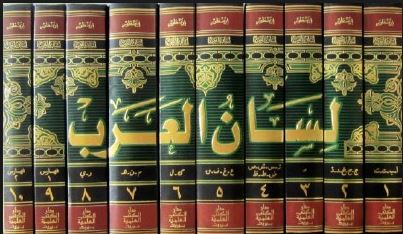
Lisān al-`Arab. Recent 10 vol. Beirut edition.
The لسان العرب Lisān al-`Arab (The Tongue-Language of the `Arab[s]) of Ibn Manẓūr : Ibn Manzur, Lisan al-'Arab, 18 vols. (Beirut: Dar Ihyab al-Turath al-'Arabi, 1997), refer vol. 6: 203.4
[4] Lisan al-`Arab li-Ibn Manẓūr, ed. `Abd Allah `Ali al-Kabir, Muhammad Ahmad Hasab Allah, Hashim Muhammad al- Shadhili]. Tab`ah jadidah muhaqqaqah wa-mashkulah shaklan kamilan wa-mudhayyalah bifaharis mufassalah. Cairo: Dar al-Ma`arif,1981. Also Beirut: Dar Sadir, 1955-6. 1: 571; Ibn Manzur, Lisan al-'Arab, 18 vols. Beirut: Dar Ihyab al-Turath al-'Arabi, 1997), 6: 203. Ibn Manūr, Muhammad ibn Muxarram, Lisān al-`Arab Vol. 1 (Revue et Complete Youssef Khayat, Beirut: Dār Lisān al-`Arab) pp.35-6. For a pdf of the bahā' entry of the Lisān al-`Arab see :
This important dictionary registers the verbal noun (maṣdar) derived from the root letters B-H-A as bahā' and refers to three synonyms :
- العظم = al-`izam or `uzm, meaning "Mighty", "Greatness", "Magnitude", "Grandeur", "Sublimity", etc
- الجلال = al-jalāl = "Weighty", "Lofty", "Momentous", "Sublimity", "Splendour", "Glory", etc and
- الحسن = al-ḥusn = "Beauty", "Handsomeness", "Prettiness", "Loveliness", "Excellence","Superiority", "Perfection", etc. (Hans Wehr definitions). ... "And as for al-bahā' (بهاء ) it refers to a she-camel (al-nāqa) which is comfortable with its milker (al-ḥālib)..."
Fīrūzābādī, Muḥammad ibn Yaʻqūb Fīrūzābādī (c. 1329-1414-5).
القاموس المحيط
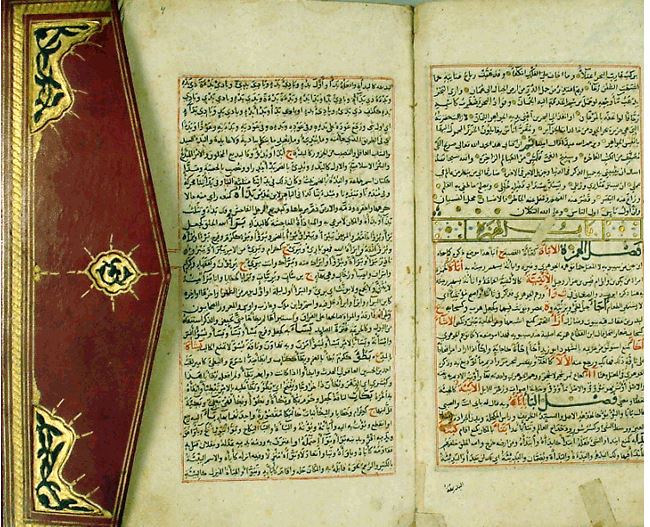
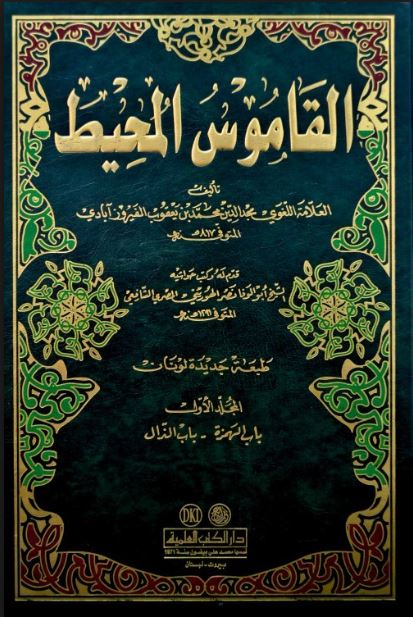
Image from the Near East Collection at Yale University Library + Modern Beirut, 2007 4 vol. Printing.
The al-Qāmus al-muḥīṭ (Comprehensive Lexicon). 5
[5] al-Qamus al-muhit The comprehensive dictionary, with the glosses of Nasr al-Hurini, rev. by Mustafa Anani. 2nd ed. Cairo, al-Matba`at al-Husainiyah al-Missriyah, 1344 /1925-26; al-Qamus al-Muhit, 2 vols. Beirut: Dar Ihya al-Turath al-'Arabi, 1997.
Muhammad ibn Muhammad Murtaḍā́ al-Zabīdī (1732-1791).
The Tāj al-`arūs min jawāhir al-qāmūs ("The Crown of the Bride from the Jewels of the Lexicon").
-
تاج العروس من جواهر القاموس
- Tāj al-`Arūs min Jawāhir al-Qāmūs. Kuwayt: Maṭbaʻat Ḥukūmat al-Kuwayt, 1965-1997.
Freytag, Georg Wilhelm (b.. Lüneburg, Germany, 1788-1861) : Lexicon.
- Lexicon arabico-latinum ex opere suo maiore in usum tironum excerptum edidit G. W. Freytag. Halis, Saxonum, apud C. A. Schwetschke et filium, 1837.
- Lexicon Arabico-Latinum : praesertim ex Djeuharii Firuzbadiique et aliorum Arabum operibus, adhibitis Golii quoque et aliorum libris confectum. 4 vols. Halis Saxonum : Apud C.A. Schwetschke et Filium, 1830-1837.
- Arabic-Latin lexicon. Piscataway, NJ : Gorgias Press, 2007.
- https://catalog.hathitrust.org/Record/001228818
- https://babel.hathitrust.org/cgi/pt?id=mdp.39015053155126;view=1up;seq=1
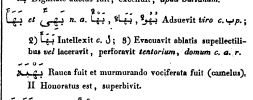
Freytag, Lexicon arabico-latinum... 1837 page 41.
Edward William Lane (1801-1876 CE): Arabic English Lexicon (1st ed. London 1863-1893),
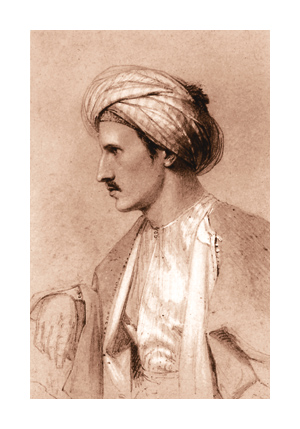

Edward William Lane (1801-1876 CE)
The Cambridge Arabist Arthur J. Arberry (d. 1969 CE) has written that "The Englishman Edward William Lane (1801-1876) was the third son of the Rev. Dr. Theopholus Lane, a grand nephew of the painter Gainsborough on his mother's side" (Oriental Essays, 87). Needing warmer climes after contracting tuberculosis ("consumption") and quitting Cambridge University Lane travelled to Egypt in 1825 where became fluent in Arabic and a subsequently a master Arabic lexicographer. He consulted many important and bulky Arabic dictionaries in putting together his own Arabic-English Lexicon which was 30 years in the making, occupying him from 1863 until his death in 1876. After his passing his nephew S. Lane-Poole managed to have the lexicon published, the first part of the first edition coming out in 1893. The work was of very considerable magnitude being partly based on the famous Arabic lexicon named Tāj al-'Arus of the 18th century polymath Muhammad Murtada al-Zabedi (1732-1791) printed in the early 19th century in Cairo in ten huge folio volumes. Lane's lexicon has become a standard reference work for Western academics as well as Arab scholars. It was composed "with the munificent assistance of the Duke of Northumberland [Lord Prudhoe] and the bounty of the British government". It remains in print and electronically available on CDRoms and in cyberspace. See further :
![]()

- An Arabic-English Lexicon. Book I, Parts 1-8. London 1863-93.
- An Arabic-English lexicon, London: Edinburgh, Williams and Norgate, 1863-93.
- E.W. Lane, Arabic English Lexicon 2 Vols. in 1 (Cambridge: Islamic Texts Society Trust, 1984), vol.1: 263-4
- http://lexicon.quranic-research.net/
The English orientalist and linguist Edward Lane (d.1876 ) compiled a now very famous lexicon primarily during the several years of his 19th century sojourn in Cairo (Egypt) which he entitled ADD . Therein he condensed the contents of several of the major Arabic lexica which had come to be regarded as authoritative including
The entry for بهاء and associated words can be found in volume 1 p 263ff esp. 270: refer PDF

The following few extracts may also be cited here: Baha':

... Bahiyy
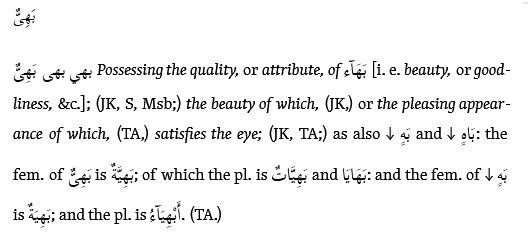
,,, Abha the superlative
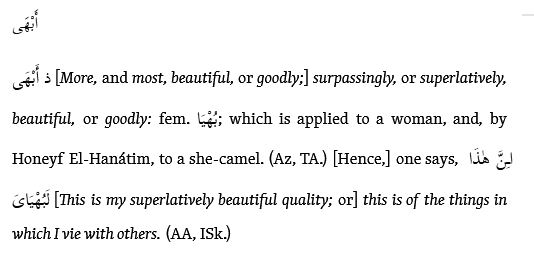
George Percy Badger (1815-1888).
The An English-Arabic lexicon of Badger
- An English-Arabic lexicon, in which the equivalents for English words and idiomatic sentences are rendered into literary and colloquial Arabic. Beirut : Reprinted by Librairie du Liban, 1967.
Reinhart Pieter Anne Dozy (1820-1883) : Supplément.
- Supplément aux dictionnaires arabes. 2 vols. Leyde: E. J. Brill, 1881.
- R. Dozy, Supplément aux Dictionnaires Arabes Vol.1 Leyde: E. J. Brill, 1884, pp.123-4.
- Supplément aux dictionnaires arabes. Beyrouth,Librarie Liban, 1968.
Régis Blachère (1900-1973)
- Dictionnaire arabe-français-anglais (langue classique et moderne) Arabic/French/ English dictionary, par Régis Blachère, Moustafa Chouémi et Claude Denizeau. Paris, G.-P. Maisonneuve et Larose. c1964 (?).
The Arabic Wordbook of Hans Wehr (1909-1981), ed. J. Milton Cowan. "Modern Written Arabic".
Hans Wehr, A Dictionary of Modern Written Arabic [Ed. J. Milton Cowan], Weisbaden: Otto Harrassowitz, 1979, p.97
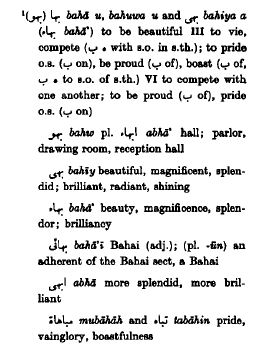

Third Cowan trans. ed. p.80.
The German Arabic dictionary entitled Arabisches Wörterbuch (1952) by Professor Hans Wehr (d. 1981), an Arabist at the University of Münster from 1957-1974, was edited in English as ` A Dictionary of Modern Written Arabic' (4th edition, Weisbaden: Otto Harrasowitch, 1979 ) by J. Milton Cowan (ISBN 3-447-02002-4 ISBN-13 978-3-447-02002-2). This work includes the triliteral verbal root B-H-A/W (بهو and بها) referring to forms I, III and VI including the verbal noun bahā' = بهاء and seven or so other derivatives. This occupies just over twenty lines of the right-hand column on page 80 (3rd ed.) 97 (4th ed.). The root form and transliteration are set down as follows then the meaning of the verbal forms III and VI:
- "(بها ) بهو bahā u, bahuwa u and بهى bahiya a بهاء (bahā') to be beautiful..
- III [3rd form= ] to vie, compete ( ب), with someone in something.... .
It can be deduced that Hans Wehr (Milton Cowan) understood form III of the root B-H-A/W (which has an alif after the initial consonant, hence با- ا- ه -) has meanings revolving around engaging in, competing, exhibiting personal pride and the act of boasting. Form VI has very similar senses. For details, see the Wehr-Cowan p. 80 image on the above right)..
In the most recent (5th?) edition of this dictionary published in Arabic-German only in 1995.
- A Dictionary of Modern Written Arabic. Otto Harrassowitz, Publisher, Weisbaden, 4th Edition, 1979, 1301 pages.
♦
Select Modern Persian Encyclopedias, Lexica, Dictionaries and Grammars ...
Steingass, Francis Joseph (1825-1903).
In 1884 Francis J, Steingass published his 2 volume `The student's English-Arabic dictionary', London : W.H. Allen & Co., 1884.
A comprehensive Persian-English dictionary...
1st edition 1892.
Francis Joseph Steingass; Francis Johnson; John Richardson; Charles Wilkins ...
- Persian-English dictionary : including the Arabic words and phrases to be met with in Persian literature ; being Johnson and Rochardson's Persian, Arabic, and English dictionary. London : Routledge & Kegan Paul, 1984. viii, 1539..
- A comprehensive Persian-English dictionary : including the Arabic words and phrases to be met with in Persian literature, being Johnson and Richardson's Persian, Arabic, and English dictionary. London ; New York : Routledge, 1995. viii, 1539 pages.
- A comprehensive Persian-English dictionary, including the Arabic words and phrases to be met with in Persian literature. Being Johnson and Richardson's Persian, Arabic, and English dictionary, revised, enlarged and entirely reconstructed. Beirut, Librairie du Liban [1970].
- A comprehensive Persian-English dictionary. New Delhi : Munshiram Manoharlal, 1996.
- Persian-English dictionary ... 6th impression. London : Routledge & Kegan Paul, 1977.
The word bahā meaning "precious, valuable" (Steingass, 210).
Under Persian بها bahā (without hamza, as in the Arabic bahā') Steingass gives the meaning "price, value". He then lists various Persian verbal phrases associated therewith including: ADD ...... Bahā'ī khūn = "The price of blood (which is payed to the relations of a person killed, as an atonement) (p.209).
In his ESW Bahā'u'llah address Shaykh Muhammad Tāqī Najafi and at one point refers the Bahā'i martyr Najaf `Alī who was faithful to Bahā'-Allah in martyrdom and thus kept his khun-bahā or "bloodmoney":
"O Shaykh! If things such as these are to be denied, what shall, then, be deemed worthy of credence? Set forth the truth, for the sake of God, and be not of them that hold their peace. They arrested his honor Najaf-'Ali, who hastened, with rapture and great longing, unto the field of martyrdom, uttering these words: "We have kept both Baha and the khun-baha (bloodmoney)!" With these words he yielded up his spirit. Meditate on the splendor and glory which the light of renunciation, shining from the upper chamber of the heart of Mulla Ali-Jan, hath shed. He was so carried away by the breezes of the Most Sublime Word and by the power of the Pen of Glory that to him the field of martyrdom equalled, nay outrivalled, the haunts of earthly delights. Ponder upon the conduct of Aba-Basir and Siyyid Ashraf-i-Zanjani. They sent for the mother [74] of Ashraf to dissuade her son from his purpose. But she spurred him on until he suffered a most glorious martyrdom" (Bahā'u'llah, Epistle to the Son of the Wolf, 73)
Lists the word bahā'ī as meaning "xxx, xxx" (p.00).
Dehkhuda, `Ali Akbar (1879-1955).
- Lughat'namah of `Ali Akbar Dihkhuda. Tehran : Danishgah-i Tehran, 1946>
Tehrani, Aqa Buzurg (1293--389 AH = 1876-1970 CE)
= Muhammad Muhsin ibn Ali ibn Muhammad Rida' ibn Muhsin ibn 'Ali Akbar. Shi~i scholar and bibliographer...
- al-Dhari`a ila tasanif al-shi`a. Tehran and Na jaf, 1353-98.
- al-Dhari`a ila tasanif al-shi`a 26 vols. Beirut: Dar al-Adwa', 1403/1983.
- al-Dhari`a ila tasanif al-shi`a. 29 vols. Beirut:
- CDRom.
Hayyim, Sulayman.
- Farhang-i yak jildi-i Farsi-Inglisi : ba tarjumah-'i Inglisi-i muhimmtarin va mutidavaltarin lughat va istilahat-i Farsi, bi-inzimam-i amsal va ta'birat-i masali (dar hudud-i 45000 madih) ta'lif-i S. Hayyim. Tihran : Kitabfurushi Birukhim, 1969.
- Haim's one-volume English-Persian dictionary: designed to give the Persian equivalents of the most important and the most common English words and phrases about 60,000 in number by S. Haim. Teheran: Farhang Moaser, 1952, 1984 printing.
- The larger English-Persian dictionary: designed to give the Persian meanings of 80,000...
- Dictionaries of Middle Eastern Languages words, idioms, phrases and proverbs in the English language, as well as the transliteration of difficult Persian words by S. Haim. Tehran: Farhang Moaser, 1985.
Haydari, Parviz.
- Farhang-i Khayyam: Almani Farsi, [Farsi-Almani] = Deutsch-persisches Worterbuch, [Persisches-deutsch Worterbuch Khayyam] : havi-i 40000 vazhah ba mutaradifat va mushtaqqat-i sahih va sarf-i af'al-i biqa'idah , [dara-yi 50000 vazhah-'i basit va murakkab-i Farsi, hamrah ba lughat-i adabi, fanni, pizishki, bazargani va san'ati] / ta'lifi Duktur Haydari. Chap-i 12. [Tehran] : Kitabfurushi- i Khayyam, 1366/ 1987



